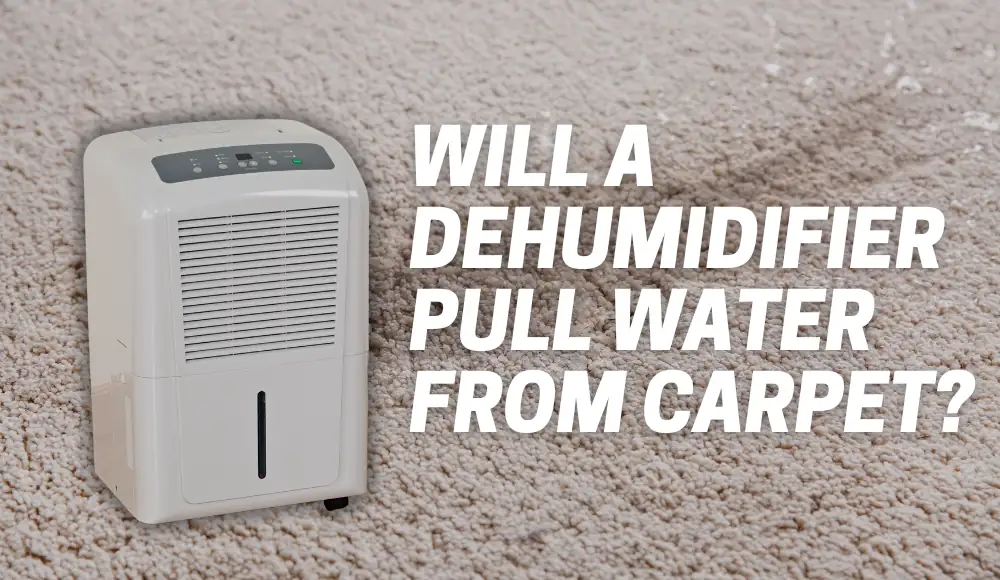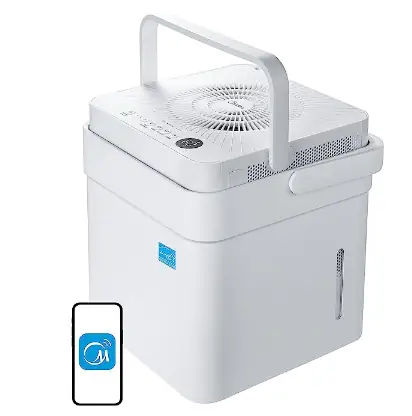If you’ve ever dealt with a wet carpet, you know how frustrating it can be. Whether it’s due to a leak, a spill, or flooding, the last thing you want is to have a damp, musty carpet in your home. In such situations, a dehumidifier can be a lifesaver. But the question remains: will a dehumidifier pull water from carpet? Let’s dive into the world of dehumidifiers and explore how they work, their effectiveness in drying carpets, and whether they are the best solution for your specific situation.
What Absorbs Water Out of Carpet?
First things first.
Before we jump into the specifics of dehumidifiers, it’s important to understand what absorbs water out of carpet in the first place.
When a carpet gets wet, the water tends to seep deep into the fibers, making it difficult to remove. In such cases, a combination of techniques is often necessary to effectively dry the carpet.
One method that helps absorb water from carpets is blotting. Using a clean, absorbent cloth or towel, gently press it onto the wet area to soak up as much moisture as possible. Repeat this process with dry sections of the cloth until you can no longer extract water.
Additionally, you can sprinkle baking soda on the damp areas to absorb odors and aid in drying.
However, these techniques primarily address surface moisture and may not be sufficient for thoroughly drying the carpet. That’s where a dehumidifier comes into play.
How Does a Dehumidifier Work?
Dehumidifiers are designed to reduce the humidity levels in a given space.
They work by drawing in moist air, removing the excess moisture, and then releasing the drier air back into the room. The process begins when air is pulled into the dehumidifier using a fan. The air passes over a set of cooled coils, causing the moisture to condense into water droplets.
These water droplets then collect in a container or drain away through a hose. The drier air is then reheated and expelled back into the room, effectively reducing the overall humidity levels.
By controlling humidity, dehumidifiers can help prevent mold growth, eliminate musty odors, and aid in drying damp areas, including carpets.
—
Can You Use a Dehumidifier to Dry Carpet?
Yes, you can certainly use a dehumidifier to dry a wet carpet.
While a dehumidifier alone may not be sufficient for completely drying a soaked carpet, it plays a crucial role in the overall drying process. By extracting excess moisture from the air, a dehumidifier accelerates the evaporation of water from the carpet fibers.
To effectively dry a carpet using a dehumidifier, follow these steps:
- Remove any standing water: If there is standing water on the carpet, use a wet/dry vacuum or a specialized carpet cleaner to extract as much water as possible before using the dehumidifier.
- Set up the dehumidifier: Place the dehumidifier in the affected area, ensuring it has proper airflow. Position it away from walls or other obstructions to allow air circulation.
- Switch on the dehumidifier: Set the dehumidifier to a humidity level between 30-50% for optimal drying. Depending on the severity of the moisture, you may need to run the dehumidifier continuously until the carpet is dry.
- Monitor and maintain: Regularly check the water collection container or the drain hose to ensure proper functioning. Empty the container or ensure the hose is clear to allow uninterrupted operation.
By combining the use of a dehumidifier with other drying techniques, such as blotting and increasing airflow with fans, you can significantly speed up the drying process and minimize the risk of mold growth.
Is a Fan or Dehumidifier Better for Drying Carpet?
When it comes to drying a carpet, both fans and dehumidifiers serve important roles.
While a fan helps increase airflow and promotes evaporation, a dehumidifier tackles the excess moisture in the air. Together, they can be a powerful combination for drying carpets effectively.
Fans help by circulating air over the wet carpet, which speeds up the evaporation process.
However, fans alone may not be sufficient in humid conditions, as they do not address the moisture in the air. That’s where a dehumidifier comes in. It helps remove the excess moisture from the air, preventing it from reabsorbing into the carpet fibers and slowing down the drying process.
In most cases, using both a fan and a dehumidifier simultaneously is the best approach for drying a carpet quickly and efficiently.
The fan aids in evaporation, while the dehumidifier controls the overall moisture levels, creating an environment conducive to rapid drying.
Will a Dehumidifier Pull Moisture Out of Carpet?
A common concern when using a dehumidifier on carpet is whether it will effectively pull moisture out of the fibers.
While a dehumidifier can remove excess moisture from the air, its ability to directly extract water from deep within the carpet is limited.
The primary purpose of a dehumidifier is to control the humidity levels in a space, which indirectly aids in drying the carpet. By reducing the overall moisture content in the air, the dehumidifier accelerates the natural evaporation process.
As the air becomes drier, moisture trapped in the carpet fibers will gradually evaporate and be drawn into the air, where the dehumidifier can remove it.
However, keep in mind that the effectiveness of a dehumidifier in drying a carpet depends on several factors, including the severity of the moisture, the size of the affected area, and the conditions in the room.
In cases of severe water damage, it’s crucial to consult professional carpet cleaners or restoration services for proper remediation.
Will a Dehumidifier Help Dry Carpet: Reddit and Forums Advice
When it comes to seeking advice and experiences on using a dehumidifier to dry carpets, online platforms like Reddit and forums can be helpful resources.
Many individuals share their personal experiences, tips, and insights based on real-life situations.
In various Reddit threads and forums, users have shared success stories about using dehumidifiers to dry carpets. They highlight the importance of combining multiple techniques, such as blotting, using fans, and running dehumidifiers, to achieve the best results.
Users often emphasize the need for patience, as drying a carpet thoroughly can take time, especially in cases of significant water damage.
| Main Point |
|---|
| Dehumidifiers draw out moisture trapped under wet carpets. |
| Use a wet vac to remove standing water from the carpet. |
| Use a big blower fan and a dehumidifier in addition to the wet vac for effective drying. |
| Rent a carpet shampooer for extraction, then use a dehumidifier, multiple fans, and adjust the humidity to reduce overall moisture. |
| Call a carpet cleaner for extraction services, use fans, and increase heat in the house for drying. |
| If the pad is soaked, it may need to be replaced. Consider professional assistance. |
| Mold and health risks can occur if the carpet remains wet for too long. Consider removing the carpet and address the flood issue. |
| If possible, lift the carpet, dry it outside, and reattach it using heavy-duty glue. Consider professional assistance if needed. |
| Use towels to soak up extra moisture, and run a dehumidifier and a fan. |
| Lift the carpet and use fans to blow air underneath it. |
| Lifted the carpet, replaced the wet padding, dried the floor, sprinkled baking soda, and removed it with a shop vac. Scheduled a steam clean. |
| Use a wet-dry shop vac, fans, or a dehumidifier for drying the carpet. |
| Use floor drying fans and a dehumidifier for effective drying. |
| Use a box fan and a dehumidifier in a closed-off room for at least 3 days of drying. |
| A dehumidifier combined with a fan can help dry the carpet faster. Use a wet vac for spills. |
It’s essential to remember that while these platforms provide valuable insights, each situation is unique, and professional guidance should be sought for severe water damage or mold issues.
Is It Okay to Put a Dehumidifier on Carpet?
Putting a dehumidifier directly on carpeted surfaces is generally safe and acceptable. However, to ensure optimal performance and prevent any potential issues, it’s recommended to follow these guidelines:
- Use a dehumidifier with a flat, stable base: Ensure the dehumidifier has a solid base to prevent any tipping or instability when placed on the carpet.
- Check for proper airflow: Avoid placing the dehumidifier against walls or furniture that may obstruct the airflow. Leave sufficient space around the unit to allow for adequate air circulation.
- Regularly inspect the carpet: Periodically check the carpet beneath the dehumidifier for any signs of moisture accumulation or damage. If you notice any dampness or discoloration, adjust the position of the dehumidifier or consider using additional drying techniques.
While it’s generally safe to put a dehumidifier on the carpet, it’s important to exercise caution and monitor the carpet’s condition throughout the drying process.
How to Use a Dehumidifier
Using a dehumidifier effectively requires following a few essential steps. Here’s a simple guide to help you make the most of your dehumidifier when drying a carpet:
- Prepare the space: Remove any standing water from the carpet using a wet/dry vacuum or a specialized carpet cleaner. Ensure the area is clear of any objects or furniture that may hinder proper airflow.
- Position the dehumidifier: Place the dehumidifier in the affected area, making sure it has sufficient clearance from walls and other obstacles. Ideally, position it near the wettest area of the carpet.
- Set the desired humidity level: Most dehumidifiers allow you to set the desired humidity level. Aim for a range between 30-50% humidity, which is optimal for drying carpets. Adjust the settings based on the severity of the moisture and the recommendations of the manufacturer.
- Switch on the dehumidifier: Turn on the dehumidifier and let it run continuously until the carpet is dry. Check the water collection container regularly to ensure it doesn’t overflow. If your dehumidifier has a drain hose option, ensure it is properly connected and directed to a suitable drainage point.
- Monitor the progress: Keep an eye on the drying progress by assessing the carpet’s moisture level. You can use a moisture meter or simply touch the carpet to feel for dampness. Depending on the circumstances, drying a carpet may take anywhere from a few hours to several days.
- Complete the drying process: Once the carpet feels dry to the touch, continue running the dehumidifier for an additional 24-48 hours to ensure any residual moisture is eliminated. This step helps prevent mold growth and ensures a thorough drying process.
—
Remember, proper ventilation and airflow contribute to effective drying. If possible, open windows or use fans to increase air circulation in the room.
How Long Does It Take a Dehumidifier to Dry a Carpet?
The time it takes for a dehumidifier to dry a carpet depends on various factors, including the extent of moisture, the size of the area, the conditions in the room, and the dehumidifier’s capacity.
In general, drying a moderately wet carpet using a dehumidifier can take anywhere from 24 hours to several days.
It’s important to note that severe water damage or flooding may require professional assistance for effective and safe drying. In such cases, relying solely on a dehumidifier may not be sufficient, and specialized restoration services should be consulted.
Best Dehumidifier for Wet Carpet
Choosing the right dehumidifier for drying a wet carpet can greatly impact the efficiency and effectiveness of the drying process.
Here are a few factors to consider when selecting a dehumidifier:
- Capacity: Consider the dehumidifier’s capacity or pint rating, which indicates the amount of moisture it can extract within a 24-hour period. For drying a carpet, a dehumidifier with a higher capacity is generally preferable.
- Portability: Opt for a dehumidifier that is easy to move and maneuver. This allows you to position it closer to the wet areas of the carpet and ensure proper airflow.
- Drainage options: Look for dehumidifiers that offer flexible drainage options, such as a built-in collection container or a hose for continuous draining. This can help minimize maintenance and ensure uninterrupted operation.
- Additional features: Some dehumidifiers come with features like adjustable humidity settings, timers, and air filters. While these features may not directly impact the drying process, they can enhance overall convenience and air quality in the room.
To help you get started, here are a few dehumidifiers that have received positive reviews from users:
#1 AIRGJOB 70-Pint Energy Star Dehumidifier
#2 Midea Cube 50 Pint Dehumidifier for Basement and Rooms
#3 ALORAIR Crawl Space Dehumidifier
These dehumidifiers have received positive reviews from users and are known for their durability and performance.
When selecting a dehumidifier, consider the size of the area you need to dry, the humidity levels, and any additional features that may be important to you, such as mobility, drainage options, and energy efficiency.
Helpful Tips for Drying a Carpet with a Dehumidifier
When drying a carpet with a dehumidifier, here are a few additional tips to keep in mind:
- Act promptly: The sooner you address wet carpets, the better chance you have of preventing mold growth and further damage.
- Combine techniques: Use a combination of blotting, fans, and dehumidifiers to achieve optimal drying results.
- Monitor humidity levels: Regularly check the humidity levels in the room using a hygrometer to ensure they remain within the recommended range.
- Ensure proper ventilation: Open windows or use fans to improve airflow and aid in the drying process.
- Consider professional assistance: For severe water damage or extensive carpet soaking, consult professional carpet cleaners or restoration services.
Remember, every situation is unique, and the severity of the moisture and the size of the affected area will influence the drying time and effectiveness.
If you have concerns or doubts, it’s always best to seek professional guidance to avoid further damage or potential health risks.
Conclusion
A dehumidifier can be a valuable tool for drying a wet carpet. While it may not directly pull water from the carpet fibers, it plays a vital role in controlling humidity levels and accelerating the overall drying process.
By combining the use of a dehumidifier with other techniques like blotting and fans, you can effectively restore your carpet to its dry and cozy state.
Remember to consider the severity of the moisture, the size of the affected area, and the specific conditions in the room when using a dehumidifier.
With proper care, patience, and the right equipment, you can successfully tackle the challenge of drying a wet carpet and creating a clean, comfortable living space.






